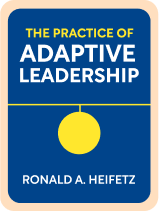

This article is an excerpt from the Shortform book guide to "The Practice of Adaptive Leadership" by Ronald A. Heifetz. Shortform has the world's best summaries and analyses of books you should be reading.
Like this article? Sign up for a free trial here .
Is your organization well-equipped to adapt to changing circumstances outside of your control? What can you, as a leader, do to increase your organization’s adaptive capacity?
Every time your organization successfully addresses an adaptive challenge, it increases its adaptive capacity and is more prepared and equipped to handle the next adaptive challenge. You can additionally increase your organization’s adaptive capacity by building an adaptable culture.
In this article, we’ll take a look at the five qualities of an adaptive organization.
Quality #1: People Acknowledge Problems
In adaptive organizations, everyone is allowed and even encouraged to bring up problems and ask uncomfortable questions, even of senior leaders:
- Senior leaders support whoever brought up the problem and help facilitate conversation about it.
- Rituals encourage conversation and the sharing of different perspectives. When bringing things up is the norm, it doesn’t require bravery.
- For example, an adaptive organization might end every meeting by asking people if they see any potential problems on the horizon. This makes bringing up problems an accepted regular occurrence.
As a result, these organizations catch problems early, before they can spiral into disasters.
- For example, Intel is an adaptive company, and it’s common for the leader of meetings to openly ask about elephants in the room. Then, the company can address them early.
To develop this quality at your organization:
- Lead by example. People look to authority for clues about how to behave. If you, as a leader, regularly acknowledge uncomfortable problems, other people will start doing it too. It also works the opposite way—if you behave in a way that’s not conducive to adaptive change, those who model you will do the same.
- For example, the CEO of a global bank was conflict-averse. This made everyone else in the organization act conflict-averse, so no one brought up a project that was failing because discussing it could have caused conflict.
- Encourage troublemakers. See Technique #4 in Chapter 6 for more details.
Quality #2: People Care About the Whole Organization
The second quality of adaptive organizations is that people are invested in the well-being and future of the entire organization, not just that of their team and department. This aids adaptability because adaptation requires working together across departmental lines.
Here are some signs that people care about the whole organization:
- People discuss things outside of their area at meetings.
- Compensation structures prioritize the company’s performance rather than a team’s or individual’s.
- If one department encounters a complicated problem, other department heads consider it something they need to address too.
- Departments share people and resources.
- People low in the organizational chart have company-related concerns.
- People share their knowledge across the whole organization.
- People in leadership positions have worked in a variety of the organization’s departments.
- People “job shadow”—they follow their coworkers around to learn what their workdays are like and take the helpful techniques they learn back to their own departments.
For example, Toyota is adaptive. One aspect of their company culture that encourages organization-level investment is that assembly line workers are expected to stop the line if they notice an issue that’s outside the scope of their formal role.
Quality #3: People Use Their Brains
The third quality of adaptive leadership is that people come to their own independent conclusions rather than looking to a leader for instruction or doing whatever they think the leader would like best. People are open to changing their opinions if they get new information, and people at the lower levels on the organizational chart are encouraged to come up with ideas and make decisions. The more brain power an organization can harness, the higher its capacity for adaptation.
It can be hard to develop judgment skills in others because as a leader, you might enjoy feeling indispensable and important. However, dependence on leaders is detrimental to the organization. To encourage independent judgment:
- Only do the things that no one else can do. Whenever you have to do a task or make a decision, if someone else could do it, let them.
- Tell your people that you don’t always know what to do. This will force them to pitch in.
Quality #4: People Develop Leaders
The fourth quality of adaptable organizations is that they develop talent. For example, GE’s Jack Welch was groomed to lead the company by a previous CEO. Hiring talented people and putting them in appropriate positions is one of the best ways to develop adaptability because a common growth limitation is the lack of good leaders.
To develop leaders:
- Prepare individual professional development programs as well as regular debriefings on real-life leadership challenges.
- Make leadership training daily and part of on-the-job supervision.
- Create clear succession paths. Determine who can replace (and ideally surpass) you. Focus on their development and train them to do so while you’re still around.
Quality #5: People Are Committed to Learning
Because adaptation is about finding new ways to solve problems, the last quality of adaptive organizations is valuing learning, a key ingredient for adaptability. Everyone in the organization admits there are gaps in their knowledge and takes steps to close them:
- Mistakes are seen as a learning opportunity and people who make them aren’t punished.
- Front-line workers are consulted on strategic decisions because they’re closest to the action.
- People from all levels of the organization are invited to set agendas and attend off-sites and retreats.
- When something goes wrong, it becomes a case study.
- Senior leaders are encouraged to go on leaves of absence and sabbaticals because these provide learning opportunities.
- Senior leaders encourage people to interact with those they wouldn’t normally encounter, both within the organization and outside of it. (Shortform example: A leader might organize a conference that people from all over the world attend.)
- Senior leaders encourage rumination. For example, they might schedule a meeting that doesn’t have an agenda so people can talk about whatever they need to.
- Senior leaders have coaches outside the organization.
- The strategic plan isn’t set in stone—it changes as new information comes to light.
To encourage a commitment to learning:
1. Explore the following reflection questions. People at all levels of the organization should regularly ask these questions because they help to develop an ability to adapt and innovate, which will help the company grow. (Reflection might not seem like a good use of time when there are concrete tasks to be doing, but the authors have found that reflection is a major part of developing the capacity to adapt.)
- What external conditions are changing?
- What kind of internal challenges do these external changes cause?
- Where are we now compared to where we hope to be?
- How can we judge success?
- What new challenges might we encounter soon?
2. Encourage smart risk-taking (low-cost risks that people can learn a lot from). Regardless of whether the experiment succeeds or fails, if the experimenter learns from it, they can apply this to the next experiment. To encourage this kind of risk-taking:
- Ask your reports to brainstorm new workflows and techniques for doing existing duties.
- When people undertake experiments, clear their to-do lists so that they can focus on the experiment, and give them the resources they need.
- When people run into difficulties, acknowledge that learning from experiments is challenging.
- During performance reviews, make risk-taking a goal for the coming time period and help people come up with specific experiments.
- Lead by example—run experiments yourself and tell people about the results.
3. Reward experimentation. It’s not enough to encourage learning experiments; you must also reward those who undertake them. Rewarding is especially important when the experiment fails—if people are punished for taking a risk that didn’t pay off, they’ll keep future experiments to themselves (minimizing learning), they won’t experiment at all, or they’ll leave your organization for one more friendly to experimentation. Therefore, the reward system shouldn’t reward successful outcomes, but instead reward a high number of experiments, commitment to experimentation, or how well people learn from experiments.
4. Encourage action on experiments. Some people spend a lot of time planning the experiment to minimize the risk involved in conducting it. But in reality, it’s impossible to control the outcome of an experiment—by nature, experiments discover something new—so encourage people not to get bogged down in planning.
5. Run multiple experiments at once. This will help you and your organization learn quickly because it gives you lots of data to consider. It will also help you show that you’re committed to experimentation and adapting.

———End of Preview———
Like what you just read? Read the rest of the world's best book summary and analysis of Ronald A. Heifetz's "The Practice of Adaptive Leadership" at Shortform .
Here's what you'll find in our full The Practice of Adaptive Leadership summary :
- How to deal with unknown solutions that require innovation, experimentation, and adaptation
- How to determine if a problem is technical or adaptive
- Five tips for launching initiatives to address adaptive challenges






